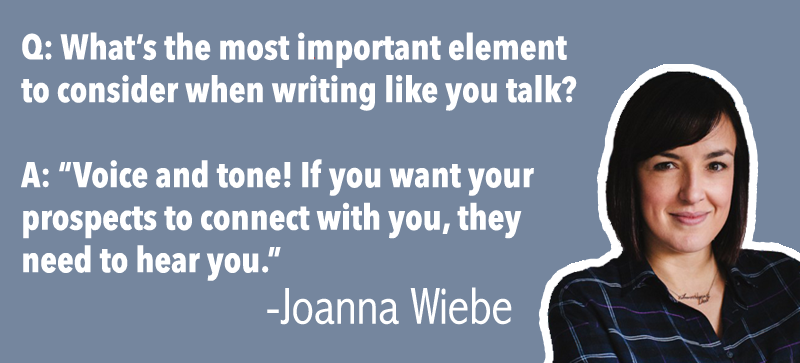
Unless you’re writing a scholarly essay, the way we’ve been taught to write in school is way too formal. I think this approach directly clashes with the way we read online, in a nutshell — it’s outdated.
This formalized writing style makes everyone’s sound the same when they write. Leaving less room for a person’s personality to shine through in their writing.
Let’s discuss why this is the wrong approach to writing and why it’s better to write like you talk to get your point across.
Why You Should Write Like You Talk
I’m definitely guilty of publishing articles in the past that were too wordy, riddled with academic language and followed an overly strict structure making them boring.
To a reader, overly formal writing like this comes off as robotic.
It doesn’t feel like you’re reading something a person wrote, but instead, a manufactured piece with a motive behind it, that’s hard to get through.
I’m definitely not saying everything you write for yourself or in business needs to be the next great American novel, but it must clearly reflect your unique perspective.
When you’re talking with a person you get a strong sense of their personality, their intent and the context of their word choice.
It’s easier to feel an emotional connection to what they are saying, as well as decide whether or not you trust what’s being said.
This is what you’re trying to emulate in your writing as an individual or on behalf of a business.
When you write like you talk, you’re able to share your viewpoint in a conversational tone that’s aligned to the reader.
Your tone when you speak changes when you’re talking to your mom versus a coworker versus a friend, which is important distinction to be aware of.
Writing with the tone that your most comfortable with and that best suits the audience you’re trying to reach will make your writing far more effective.
In the end, you want your writing to stand out for the right reasons and convince your readers you can be trusted, while speaking directly to their specific needs.
Whether you’re writing copy for a landing page, an eBook, a blog post or another form of written content, here are some tips for making your writing more conversational.
Quick Tips for Writing Less Like a Robot and More Like Yourself
1. For starters, you have to know the foundational grammar and punctuation rules before you bend or break them to sound more like yourself.
This is easier said than done.
I’d consider buying either the AP Stylebook or the Chicago Manual of Style to either establish or upgrade your grammar skills.
For those that consistently struggle with grammar like me, I’d suggest using Grammarly, which is a tool that recommends improvements to your writing and identifies grammar errors.
2. Short sentences are key.
If you pay attention to how you talk, you’ll notice that shorter sentences sound way more natural.
Sentences shouldn’t be too long or you sound like you’re droning on, taking emphasis away from your point.
I’ve found sentences of 20-25 words to be the max length most sentences should be, unless it’s a list.
This doesn’t mean there’s no place for a lengthier sentence, here and there.
The use of longer sentences can actually build up the emphasis for a much shorter sentence at the end of a thought or paragraph.
3. Ask questions within a piece.
Instead of simply telling the reader what to do and your opinion, reinforce what you’re saying by asking relevant questions.
Let’s say you’re writing an article on your company’s blog about a volunteer experience you had at work, it might make sense to ask a question like:
Have you ever found it difficult to find the time to volunteer?
Struggling to feel fulfilled with your day-to-day routine?
The goal here is to trigger a reader’s connection with the topic and voice the questions they might have thought of when thinking about this subject.
4. Start some of your sentences with ‘and’, ‘but’, ‘nor’, ‘for’, ‘so’, ‘yet’, or ‘or’.
Many believe it’s wrong to start a sentence with a conjunction, but this is merely another rule we’ve kept with us from school.
Some of the most compelling sentences begin with a conjunction as their use mirrors the way we talk.
But, make sure your use of conjunctions is followed by an independent clause to ensure it’s able to stand alone as a sentence.
5. Be mindful of voice and tone.
This is the most important element to consider when trying to write like you talk says Joanna Wiebe, the original conversion copywriter, creator of Copy Hackers and the cofounder of Airstory, drag-and-drop writing software for high-performing teams.
“If you want your prospects to connect with you, they need to hear you,” said Wiebe.

“A good way to think of voice vs tone when you’re writing is by thinking about how your mom sounds when she calls you for dinner the first time (voice) versus how she sounds when she calls you for dinner the third time (tone),” she said.
“Your brand’s voice comes through all the time, and sometimes the tone is stronger than other times,” she added.
“But if no one can ever hear your voice or if you’ve never got the appropriate tone for the scenario, you won’t sound authentic, you won’t take shape as a relatable ‘person’ and you won’t engage your reader’s heart or mind like you could,” said Wiebe.
6. Add interjections like ‘Ouch’, ‘Phew’, and ‘Duh’.
Adding interjections to the mix helps break-up the text and helps the reader emotionally connect with the point you’re trying to make. Hooray!
Some of the many interjections to consider including are: aha, ahem, bam, bravo, cheers, dang, eek, gadzooks, gosh, hey, holy cow, oh dear, pow, rats, thanks, wahoo, whoops and more.
7. Include ‘you’ and ‘I’ to personalize.
Pretend that you’re actually talking face-to-face with your readers by addressing them with ‘you’ when appropriate.
In addition, share your own experiences by starting sentences with ‘I’ as it’s a straight-forward way of adding a personal tone.
Like any of these tips, use them in moderation. I recommend addressing your audience directly and including your own experiences as a part of a greater mix of tactics.
8. Use similes and metaphors.
To simplify complex concepts, compare a subject to something else by using similes and metaphors in your writing.
An example of a simile is:
The technology works as fast as lightning.
An example of a metaphor:
There was a tsunami of donations for the non-profit.
9. Consider the readability of your writing.
The average person reads at an eighth-grade reading level, which is an important consideration to keep top-of-mind when you’re writing.
You’re looking to keep things simple by being thoughtful with your word choice and not including buzzwords.
Use a Free Readability tool like this one from WebpageFX.
10. Break up text.
Big bulky paragraphs online are difficult to read.
Make your paragraphs super short as they’re much easier to read online when they are only a sentence or two, maybe three tops.
11. Include contractions when possible.
When you’re speaking you wouldn’t say “she could not have”, you’d more likely say “she couldn’t have.”
Again, the aim here is to simplify your writing for readers to make it more natural.
That’s what a contraction does, shortens words by leaving out certain letters and sounds.
12. Don’t overdo it.
It’s still essential to remain professional with your writing as what you’re sharing, especially as a business, is a reflection of your expertise and authority.
This isn’t an opportunity to overuse slang, make lots of grammar errors or write in the same way you might text a friend.
Instead, the goal should be to write more conversationally to make it easier for readers to understand what you’re saying and not get lost in an overly formal piece.
What techniques do you use to be more relatable in your writing? What writers or companies do you follow that have a conversational tone? Share your thoughts and any examples you might have in the comments.


